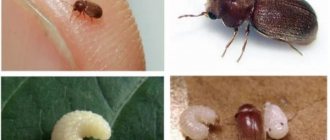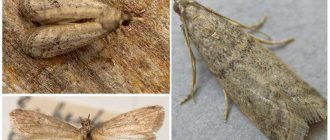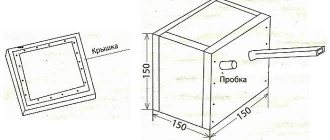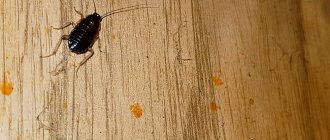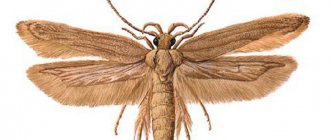The famous bread borer parasite
- Many housewives have often encountered the famous insect - the bread borer. The bug is brown in appearance, flies, eats all types of foods:
- Settles on vegetables and fruits;
- Lives well in rice, buckwheat, wheat, oats, happily attacks beans, semolina, and oatmeal;
- You can often notice the pest on baked goods; they like to eat black and white bread, crackers, and loaves;
- Settles on pasta, noodles, vermicelli, spaghetti;
- It multiplies well and quickly in flour;
- If there is cat or dog food, bugs are sure to settle there;
- An uninvited pet will also visit the trash can, it will use it for reproduction;
- If there is an accumulation of water in the sink, it will serve as a real swimming pool for the parasite;
- The insect feeds on spices; coriander is suitable for it, as a seasoning for soups, as well as meat dishes;
- The bug will settle on all kitchen items, it will appear on crusts of bread, in dirty dishes, on unwashed rags, in pans with leftover food, if the oil is not covered, and the pest will also appear there;
- The insect, without hesitation, appears on confectionery products: bagels, sugar, pancakes, donuts, jam;
- The insolent bug eats dried flowers, seeds, dried plants, tubers and bulbs.
For comrades, the bacterial feast is great for reproduction.
When preparing bread kvass, pests often appear; for them, like for others, there are no obstacles to reproduction. Larvae can be found on food products. Many housewives wonder how bugs enter the room. No one is safe from the appearance of unexpected guests and everything seems to be clean, there is perfect order all around, but pests have appeared. What's happened? They can settle on goods from the store.
Classification of bugs that can appear in the kitchen
What insects can live in an apartment? There are many varieties of house bugs, but four types usually live in the kitchen: the small beetle moth, the bread borer, the red flour beetle, and the Indian moth.
Khrushchak
A small brown insect with short antennae and a 3 mm body. Loves starch and flour. Products spoiled by the beetle take on a lumpy appearance and cause esophageal upset.
Mucoed
A small 2-mm bug of a reddish-brown color with hard wings and long antennae. Settles in wet foods. The appearance of a flour beetle is indicated by a eaten flour sieve.
Bread grinder
It is distinguished by its super gluttony and omnivorous nature. It feeds on cereals, beans, flour, tea, nuts, coffee, gingerbread, and tobacco. The body is covered with hairs, has an oval shape, and is brown in color.
What types of kitchen beetles are there?
Common insects that populate the kitchen: beetleworm, grinder, flour beetle, weevil, white bugs. They are all small, but they do a lot of harm. Acceptable living conditions for them are a temperature of +30 degrees. However, pests also feel comfortable at temperatures of +15 degrees.
Small Khrushchak
Size – up to 3 mm. The antennae are short. These little brown bugs live in the kitchen; they prefer flour and starch. Together with such products, insects are brought into the house, then they spread throughout the room. The main sign of the presence of beetleworm is the formation of lumps in bulk products.
Products spoiled by small beetles become lumpy
Red mukoed
Small bugs belonging to this species are characterized by a reddish-brown color. The size of insects is 2 mm. Unlike the Khrushchak, the mukoed's antennae are quite long. Pests primarily appear in products with a moisture level of 15% or higher, which usually occurs when stored improperly.
Red flour beetles are very small; they can ruin not only food, but also utensils
Bread grinder
Insects in the kitchen can also be represented by this species. These are omnivorous pests, as evidenced by their ability to feed not only on bulk products (cereals, legumes, flour and flour products, nuts, pet food), but also on tobacco, tea, and coffee.
Bread grinders are particularly voracious and can even grow in tobacco
The body of the beetles is oblong, color is brown. Their size is slightly larger than that of other insects and is 4 mm.
If there are few insects, they hide and are unnoticeable in the kitchen. As the colony population increases, the pests spread, so they can even appear on windowsills.
Weevil
Insects of this species infect pasta, flour and cereals. The granary weevil can be found on the territory of human habitation. Its distinctive feature is its elongated rostrum. The body size reaches 4 mm, the color is dark brown. The barn weevil cannot fly due to underdeveloped wings.
The beetle prefers grains of wheat, barley (barley), rye, rice, and less often damages corn and buckwheat.
Appearance of the pest
The difference in insects lies in the size of the body, as well as the color of chitin. Bugs come in different types:
- There are individuals that have a whitish body; the size does not exceed a grain of semolina. They are not afraid of cleaning products containing chlorine. But if the kitchen is cold, the little pests will have to hide. All insects can be destroyed by opening the window in winter;
- There are flour beetles. Their body is 3–4 millimeters. They are red-brown in color, the wings are parallel. Reproduction occurs within 3 weeks. The habitat is flour and cereals. All bugs can be removed after the food has been moved to other places. Feed the contaminated food to the birds or destroy it. If legumes, including beans, are damaged, it is necessary to sort through the food and then throw away the affected food.
What to do if there are bugs?
First of all, check all the products. Most often, housewives remember flour and cereals, but insects can hide in other places.
Where to look for bugs?
Bugs are nosy and almost omnivorous insects. Therefore, if you catch your eye at least one, you need to urgently organize an audit and look for them in all sorts of “hiding places”:
- beans - favorite habitat;
- bread;
- flour and cereals;
- dried fruits;
- spices (they even live in pepper bags);
- vegetables (soft rotting onions are a reason to take a closer look);
- tea and coffee;
- cookie;
- cracks in furniture and window sills;
- kitchen appliances;
- first aid kit (bugs are susceptible to mustard plasters).
After a thorough home inspection, you need to do the following:
- If few insects are found, some of the products can be saved by calcining them in the oven or keeping them in the freezer for a day (then the flour or cereal must be sifted through a sieve). Heavily contaminated supplies will have to be disposed of.
Legumes need to be immersed in salt water and wait until the beetles and their offspring float to the surface, after which the water should be drained and the grains dried.
The garbage along with the bugs must be taken out immediately before they crawl into the cracks of the floor.
- Place unaffected products into glass jars and close tightly.
- Clear the cabinets of food and rinse with vinegar water (1 teaspoon per liter).
- Disinfect all rooms to prevent insects from breeding. Pouring boiling water into the cracks (for wooden floors) gives good results.
The main thing is to make sure that all insect habitats are declassified.
Features of small brown and black house bugs
The life of insects depends on temperature conditions. Despite the fact that brown bugs in the apartment are very tenacious, they cannot tolerate temperatures below -15C and above 50C.
Parasites that have settled in the kitchen will crap and lay eggs in the most unpredictable, hard-to-reach places (cracks in kitchen cabinets, cereals, books). Fighting them can take a lot of time and effort.
The most unpleasant pest is considered to be flour (Indian) moth. If you notice white larvae (worms) or gray butterflies in the cereal, you can safely throw away the product.
Are products suitable after being infested with bugs?
The kitchen is considered an attractive maneuver for insects. The bugs must be deprived of food as follows:
- Pour cereals and flour into glass jars with tight-fitting lids. Provide special boxes for pasta, sugar, spices, and legumes. For example, you can read how to store beans here.
- For bread, there is a place in the refrigerator or buy a durable plastic bag. At low temperatures, mold will not appear, and polyethylene will prevent it from drying out.
- If there are products for which there is not enough space in the jars, it is necessary to provide tight bags for them and tighten the neck tightly.
The problem with affected products takes the housewife by surprise. It begins to hesitate whether to destroy all the grain along with the pests, or leave the part that seems unaffected for further use. According to doctors, you should not eat foods that have bugs in them. You need to get rid of such food as soon as possible.
Flour beetle: habitat features
The most common inhabitant of the kitchen area is (otherwise known as the flour beetle) - a reddish-red beetle characterized by small (3-4 mm) sizes, short antennae, a durable shell that protects the back and head, and small underdeveloped wings.
At a favorable temperature of +23-25 o C, a female beetle is capable of producing 4 generations in a year, laying 300-350 eggs at a time. In the most fertile individuals, this figure can reach 1000. Mealworm eggs (short oval, white) in cereals are quite difficult to detect, since they are covered with a sticky liquid that quickly absorbs particles of flour and dust. Although the female is so fertile that she lays eggs wherever possible: on food, fabrics, in the crevices of cabinets. The hatched larvae immediately crawl away in search of food, easily gnaw through bags and settle in stocks of cereals and flour - the most preferred product. It is somewhat encouraging that this type of insect independently regulates its numbers. When it increases significantly, adults and larvae eat eggs and pupae.
Clusters of mucoeds can significantly spoil food supplies. For example, when flour is massively infested, it acquires a dirty color, becomes lumpy, smells bad, tastes unpleasant and is generally unsuitable for consumption. Products damaged by beetleworm are dangerous to human health and can cause an allergic reaction, dysbacteriosis and even poisoning. How to get rid of bugs in the kitchen?
Prevention in cabinets
How to prevent insects from appearing in the kitchen? The instructions consist of several sets of recommendations.
Simple logic dictates that since insects gravitate toward the kitchen, they are attracted to food.
The obvious solution is to deprive them of food supply, of what attracts their attention.
- For cereals and flour, it is worth buying jars with ground-in glass or tight-fitting lids. Pasta (including spaghetti, for which you just need a taller jar), legumes, sugar and spices are stored similarly.
- It is better to store bread in the refrigerator, in a plastic bag. The low temperature will delay the appearance of mold, and the polyethylene will prevent it from drying out.
- Products for which there are no jars of sufficient size can be simply packed again in thick polyethylene and the neck of the bag is pulled tightly together. There are a lot of ways: from a simple clothespin to a hair tie.
In the photo there is a jar that is guaranteed to protect your cereal from bugs.
Food waste
As long as the waste is accessible to insects, they will thrive. It is clear that a trash can is difficult to make airtight. However, here too preventive measures can be taken:
- Buy and use trash bags. The bag is placed inside the bucket; its neck is pulled onto the walls from the outside. In this case, rotten food debris will be completely removed from the surface of the bucket after each trip to the trash, even without thorough washing.
- Cover the bucket with a lid. It will not completely block the path of insects, but will reduce the spread of odors that attract them.
- Be careful. Insects are quite small; even a small amount of waste falling past the bucket onto the floor will provide them with food for several days ahead.
Cleanliness around the trash can is another important factor. Stale food remains in and around the bucket attract ants, bugs and cockroaches with their smell.
Furniture
The ends of shelves and cracks inside cabinets are a favorite habitat for bugs. It is advisable not to forget to putty or paint the ends of homemade shelves: chipboard or plywood unprotected from moisture dry out, forming many small cracks.
We suggest you read: Prayer for bedbugs in an apartment and a conspiracy to get rid of bedbugs
In finished furniture, it is easy to go through the seams inside the cabinet with regular clear caulk or acrylic putty. The fewer cracks inside kitchen cabinets, the fewer insects.
Small bugs in the kitchen are very tenacious creatures. Even “super housewives” are not immune from them. Small bugs in the apartment do not appear due to lack of hygiene. Pests can be introduced by purchasing already contaminated products.
When choosing pasta, flour, cereals, you need to carefully examine the packaging, check its integrity and expiration date. You should not purchase bulk products with strange impurities. It is not recommended to purchase cereals by weight or from unknown manufacturers. It is better to give preference to trusted companies that use high-quality packaging.
Make yourself a rule: immediately after purchasing, place the cereal in the freezer for a couple of days.
Following these simple rules will help reduce the risk of unpleasant guests appearing in the kitchen:
- Keep nuts and dried fruits in the refrigerator, cereals in hermetically sealed containers (transparent containers).
- For storage, you can use cloth bags boiled in a strong saline solution. Cool the bags without removing them from the solution, then dry and iron with a hot iron.
- Inspect regularly and throw away expired goods.
- Monitor food storage conditions. High humidity and temperature are a favorable environment for the appearance of bugs.
- Regularly carry out wet treatment of high-risk areas using a mixture of bleach and levomycetin (half a bottle of Belizna and 20 tablets of medicine are needed per bucket of water).
- Place the borax on the shelves.
- Arrange open matchboxes. Beetles do not tolerate the smell of sulfur, so the boxes can be installed on the cereals themselves.
- Coat cracks and crevices in cabinets, floors, and window sills.
About order in kitchen cabinets
The operation to get rid of bugs will be considered completely completed if you clean up the kitchen cabinets. To do this, all shelves should be completely emptied of contents, the remains of spilled cereals should be removed, the cracks should be filled with boiling water, and the surfaces should be wiped with a vinegar solution (a tablespoon of vinegar per liter of water). Then it is recommended to leave the cabinets for a day to dry. In the meantime, it is necessary to tidy up the containers for cereals: wash them with a solution based on laundry soap, and then treat them with boiling water. Fabric bags in which cereals were stored should be treated with a salt solution and dried without rinsing.
Methods for controlling small pests
What to do if there are small brown bugs at home? You need to start the fight as soon as you notice that small bugs have appeared in the apartment. Otherwise, their numbers will begin to grow rapidly, and it will be much more difficult to remove the parasites.
In order to get rid of beetles, you will have to be patient and time. First you need to carefully examine the pasta, cereals, flour, and dried fruits. It is worth preparing for the fact that you will have to get rid of contaminated products, even if the package was opened recently.
If the small black bugs in the apartment did not manage to occupy the entire territory, then you can try to save the food:
- Sort by hand or with a sieve, then rinse gently under running water.
- Heat in the oven at a temperature of 50C... 100C. This must be done carefully, avoiding damage to the product.
- Pour in salty solution and rinse thoroughly.
It must be said that bugs in beans are a separate case. You won't be able to get rid of them using the methods listed above. Even if only a couple of grains in the package are infected, then most likely the larvae have occupied the rest.
Experts do not recommend consuming cereals affected by bugs. Even after sorting through the product and removing adult individuals, one cannot be completely sure of the absence of larvae. The situation with flour is a little different. If you pass it through a fine sieve, then heat it in the oven, then you can talk about the purity of the product.
Heavy artillery
By throwing away contaminated products, you cannot be sure of complete victory over the bugs. There is a high probability that the insects managed to lay eggs. To finally get rid of parasites, you need to prepare bay leaves, vinegar, nutmeg, garlic, and glass containers with screw-on lids.
Bugs in cereals will disappear completely if you follow a certain scheme:
- Look through the products again, if there are no visible traces of insects, put the cereals in the freezer for a week. If the brown bugs in the kitchen managed to lay eggs, then in 7 days they will mature (or die) and it will become clear whether the food is suitable for consumption.
- Rinse kitchen cabinets several times using a good chlorine-containing cleaner (for example, Domestos) or hot vinegar water.
- If after a week the cereal remains clean, put it in glass jars with tight lids.
We suggest you read: How to get rid of mice in an apartment forever: methods of control
Throw unpeeled garlic into each container. This will protect your food from bugs in the future.
- To prevent insects from appearing in the kitchen for as long as possible, you need to place peeled garlic cloves, bay leaves on the cabinet shelves, or fix nutmeg on the doors. They hate bugs and the smell of cloves.
- A deadly poison for parasites is pyrethrum powder, which is obtained by processing Persian or Caucasian chamomile. Sold in pharmacies. Not dangerous for humans. For preventive purposes, pyrethrum can be used at intervals of 1.5-2 weeks.
- You can remove the kitchen beetle with a simple bait consisting of an equal volume of powdered sugar, fine grains and boric acid.
If there are small brown bugs at home, then you can use a radical method of control. Buy a product against as many pests as possible and apply it to the baseboards. You cannot enter the premises during the day. Then ventilate the room thoroughly and wash the treated areas.
Bugs love cereals, so look for them there
Now you know what to do if there are bugs in the kitchen.
Ways to get rid of bugs
To get rid of bugs, it is necessary to carry out a whole range of measures to destroy not only them themselves, but also their offspring, waste products. And first of all, this is, of course, to carry out high-quality cleaning. Armed with rags and sponges, you will have to open all the kitchen cabinets and empty and treat all the shelves and drawers.
We recommend: How to wash linoleum at home for shine: tools, household and folk remedies
It is necessary to carefully sweep away any remaining grains that may have spilled and simply wipe everything with a dry or slightly damp cloth. After this you can proceed to processing:
- Table vinegar works well not only with adults
, but also their larvae and eggs.
- Therefore, you need to dilute 9% vinegar approximately 1:1 with plain water and wipe all surfaces with this solution. And not only the horizontal shelves themselves, but also the vertical ones, including the doors.
- Particular attention should be paid to the joints. If your furniture allows it (not varnished), you can pour the solution into a spray bottle and spray hard-to-reach joints, for example, in the area of hinges on doors.
- Then dry the furniture thoroughly so that it does not get wet or deteriorate.
- Soda-salt solution can be used instead of vinegar. Dissolve a couple of tablespoons of ordinary rock salt and a spoonful of baking soda in a liter of warm water, stir well, the solution is ready.
Now let's move on to storage containers:
- If you choose glass or plastic containers for storage , then you need to not only wash them, but also thoroughly pour boiling water over them, which will kill the bug eggs.
- If you store cereals in fabric bags , then they should not only be washed, but also boiled.
- It’s better not to do anything with plastic bags , but simply throw them away and immediately into the garbage disposal, and not into the trash can in the kitchen, from where the parasites will quickly crawl back out.
After the main shelters of the bugs have been eliminated and processed, it is worth moving on to the remaining items. It is advisable to wipe everything with vinegar solutions: refrigerator, microwave and other appliances and furniture:
- Pyrethrum helps well; it is a flower powder that is made from Caucasian chamomile, absolutely organic and safe for humans and pets. It should be sprayed carefully in cabinets. To do this, you can simply pour a little onto a dry palm and blow gently in the direction of the shelf you need. Make sure that the powder gets into the cracks and joints.
- If your pest is a food moth, then in addition to the procedures described above, it is necessary to add treatment with any chemical agent for ordinary moths. Moreover, you also need to spray carpets, rugs, and upholstered furniture, if any.
If you choose glass or plastic containers for storage, then you need to not only wash them, but also thoroughly rinse them with boiling water, which will kill the bug eggs
What are they like?
Small beetles in the kitchen vary in chitin color and body size. Obviously they belong to different species.
The author would be sincerely grateful if entomologists could provide greater clarity; Studying the forums brought the following gallery of enemy portraits:
- Miniature bugs with a whitish body, slightly smaller than a grain of semolina. Extremely resistant to cleaning agents and chlorine-containing products; however, the little white bugs in the kitchen cannot tolerate the cold. Leaving a window open overnight in the winter can put an end to the disgrace.
- The little brown bugs in the kitchen are probably flour beetles (flour bugs). Body length – 3 – 4 millimeters; The red-brown elytra along the entire body are located strictly parallel.
The larval stage develops up to three weeks. They are located mainly in flour and cereals. The simplest way to fight is to sort through all the products; the infected ones should be sent to feed birds or disposed of in any other way.
- Small black bugs in the kitchen can be found in beans and other legumes, cereals, pasta, sugar and even red hot peppers. And here the only effective way is to sort through the products and dispose of the victims.
- Ants. They are also often mistaken for bugs due to their size, although the difference in body outline is more than noticeable. Most often, ants are found near a trash can where food waste has rotted.
However, the methods of prevention and control mentioned below should be universal.
Perhaps there is a portrait of your enemy here.
Bugs attack millet groats
There are many parasites in the environment. During the growing period, and then during collection and transportation, future cereals are affected by beetles. High temperature treatment does not have sufficient effect on the products. Insect larvae appear from improper storage standards.
If you buy pasta, flour, and cereals in bulk, the appearance of omnivorous inhabitants is inevitable. This is due to the fact that products that are sold by weight are saturated with moisture. A favorable environment is formed there, in which the larvae quickly develop. Packaged products are often surprised by unexpected “guests”. If storage rules are not followed, even tightly packaged goods will harbor bugs.
On the warpath
Let's assume that the insects are ALREADY infested. How to get rid of them with your own hands?
- As already mentioned, it is better to dispose of contaminated products. However, there is an alternative solution - bake them in the oven for 10 - 15 minutes. It is clear that the measure is only suitable for cereals, pasta and flour: for example, sugar will simply melt.
- Cabinets are disinfected not only with insecticides. By the way, bugs adapt to them no worse than cockroaches: dichlorvos drowns them in kerosene rather than poisons them. But judging by the reviews, these insects really don’t like vinegar essence and garlic. Lavender and bay leaves also repel them.
At the same time, the price of a military operation against insects, as you understand, will be very moderate: a pack of bay leaves and vinegar are cheaper than imported insecticides.
- In jars with products not intended for culinary delights, you can put a clove of unpeeled garlic.
Treatment with vinegar will work better than pesticides. At the same time, you do not risk poisoning your pets; the smell will quickly dissipate.
Who lives on kitchen shelves?
If bugs appear in the kitchen, how to get rid of them quickly and effectively? You should know that there are plenty of contenders for the contents of kitchen cabinets: bread grinders, red flour eaters. Each of these species, once in favorable conditions, significantly spoils food and actively reproduces. How to get rid of bugs in the kitchen cabinet?
Bread borers are small bugs (up to 3.7 mm in length) characterized by incredible vitality and fertility. They have a black-brown body color and a small, completely armored head. Adults do not feed: the larvae cause damage to kitchen supplies.
Penetrating into the nutrient substrate, they make numerous passages in it. They also pupate there, first gnawing out cradles in feeding areas. The specimens living in the flour glue its particles into balls and wait in them for the period of transformation into adults. Over the course of a year, approximately 3-4 generations of bread grinders develop, which can only be found in kitchen supplies, on windows, walls, and the floor of a room if there is a large accumulation of them. In small numbers, insects remain hidden in the food substrate and do not show themselves outside. Bread grinders do not disdain tea, coffee, medicinal plants, book bindings, animal feed, crushed grain mixtures; They leave many passages in them and deposit waste products.
Types of insects
An unpleasant misfortune with the appearance of pests can appear in the cleanest housewives.
- To store dried fruits and nuts, you need to find a place in the refrigerator. It is better to keep cereals fried and in tightly closed containers. Cloth bags can be provided for storing products, but before use they must be boiled in a saline solution. There should not be a single gap or crack in the floor, in cabinets, on window sills and in wooden windows. When insects appear, you need to get rid of them as quickly as possible;
- The bugs are not affected by temperature changes. They can withstand both sub-zero and hot weather. Contaminated products must be disposed of, even if large quantities remain. To treat kitchen furniture, you need to buy a strong Domestos solution. Hot water with vinegar will also help kill pests;
- During processing, it is necessary to remove all things, food, and everything that is in the kitchen and is susceptible to infection by parasites from the premises. To avoid the appearance of annoying parasites, the corners of the cabinets should be covered with bay leaves or garlic cloves. Ground nutmeg has effective properties against bugs. Crushed berries should be poured onto an adhesive plaster and placed in places where harmful inhabitants accumulate;
- During complete removal of parasites, dried fruits should not be left open. For them you need to look through the jars or refrigerator.
You can overcome the attack with the help of complete disinfection, as well as the removal of spoiled foods.
To avoid the appearance of small parasites - bugs, it is recommended to follow the deadlines indicated on the products. The norms depend on the fat content of the cereal. Because of it, the product deteriorates before other components.
We invite you to read: Where do Drosophila flies come from in an apartment or house? How to get rid of fruit flies in the apartment, in the kitchen, in flowers: tips. How to make traps for fruit flies with your own hands: instructions
Packaging material plays one of the most important roles. Before using clothes bags, they must be processed. Jars of food must be tightly closed, containers must not have entrances for bugs to enter, plastic containers must be intact, without holes. The development of kitchen insects can be prevented if all preventive measures for storing flour and bulk products are followed.
Dishes affected by bugs must be thoroughly treated with boiling water and then wiped dry. Try not to buy more than 1 kilogram of bulk products, and also not to exceed the shelf life. The more reserves, the greater the likelihood of harmful inhabitants multiplying. When purchasing a product in a store, you should check for lumps or other compactions in which insects can live.
There are the following types of “kitchen inhabitants”:
- Flour eaters.
- Grinders.
- Flour beetles.
- Food midges.
More often, a Surinamese mucoed may appear in the kitchen. This insect is 3 mm long. The color of the mucoed is dark brown. in grain crops, mainly in flour. But despite the name, the insect’s gastronomic preferences do not end with flour. Little brown bugs in the kitchen love to eat crackers and dried fruits.
Small bugs - mucoeds - are distinguished by their tenacity. They are able to lay eggs in the folds of packages, crevices and recesses of containers. On average, a small insect produces three generations of offspring per season.
If there is a small brown bug with a reddish tint in the kitchen, then it is a beetle. It is similar in appearance to the mukoeater, but has one difference - the presence of wings. It is difficult for humans to distinguish them, since the size of the insect is very small.
The Suriname mucoed is particularly resilient
Grinders have the same color as the Khrushchaki. But their favorite food is flour products. You've probably noticed small holes in bread, bagels or cookies. So this is the job of the flour grinder. The color of the flour borer changes depending on its age or variety, so if you have small black bugs in your kitchen, then these are flour borers.
If white bugs appear in the apartment, then these are possibly the larvae of existing insects. The white bugs are sugar silverfish or food midges. But if sugar silverfish rarely appear, then for the food midge the kitchen is a paradise, since it loves to settle in cereals. Food midges appear due to increased humidity levels. By appearance, a midge is difficult to distinguish from a grain of semolina.
Every housewife would like to know a remedy for small bugs, ways to prevent spoilage of their own food and preventive measures. But unfortunately, no one is safe from insects. Even the cleanest housewives.
Even regular and thorough cleaning of the kitchen will not prevent the appearance of bugs.
Small bugs appear in the kitchen for various reasons. And most of them are associated with non-compliance with storage conditions and expiration dates of products. To prevent the appearance of bugs you should:
- Store products strictly for the specified period. This applies only to cereals sold in original packaging. The peculiarity of the packaging is that it allows you to preserve the product longer due to preliminary heat treatment. Cereals purchased by weight are stored for no more than six months.
- Keep food at optimal temperature. A damp and humid room contributes to the appearance of goosebumps. Bugs are afraid of light, so it is better to store cereals in transparent containers. For storage, rooms with low temperatures are selected: refrigerator, pantry, balcony. It is worth noting that insects die at temperatures above 50 and below 15 degrees.
- Store cereals in glass containers with screw-on lids. A prerequisite is proper sealing, protection from moisture and dry air. If this is not possible, then you need to store food in plastic bags.
- Store cereals separately from each other.
- Dried fruits should be stored in the refrigerator or freezer.
Cereals should be stored in airtight jars
The following will help prevent the appearance of bugs:
- Bay leaf.
- Garlic.
- Nails.
- Lavender.
All these components are placed in containers with products. There is an opinion that small insects in the kitchen are afraid of the smell of iron.
Garlic requires preliminary peeling; it does not impart a specific smell to products and does not affect the taste. To prevent the appearance of insects in cereals, bay leaves and lavender are used in the amount of three leaves.
When purchasing cereals, pay attention to the presence of suspicious objects. If small bugs have already started to appear, then they will be visible. Don't think that if the bugs don't move, they are dead. If you find objects that are not moving, you should refuse the purchase, since when you bring the product home, they may “wake up.” Unfortunately, no one is safe from purchasing already contaminated cereals. After all, if bugs are not observed, it does not mean that there are no beetle larvae.
Grub-infested cereals: should now be thrown away
To “save” reserves you should:
- Place the cereals in a room with a temperature below 15 degrees.
- Carry out heat treatment of grain crops in the form of frying or calcination.
Tips and tricks
- The main advice is, of course, cleanliness combined with a few little tricks.
- When buying cereal or flour, do not rush to immediately pour it into a jar and put it in the cupboard. It is better to put the bag in the freezer overnight, or even for a day. If the cereal is infected, then this, of course, will not get rid of the bugs. But at low temperatures they will die, like their larvae and eggs, which means they will not reproduce and move to your other reserves.
- Make it a rule when cleaning cabinets to wipe them with a vinegar or water-salt solution. Vinegar 9%! Dilute with water 1:1 or add a spoonful of regular baking soda and salt to 1 liter of water.
- Nutmeg is a very aromatic remedy. Grind the nut as much as possible on a grater or in a mortar and, to prevent it from scattering all over the surface, take a wide piece of tape and evenly spread the resulting nut powder in a thin layer onto its strips. Then shake off the excess from the strips and cut into the amount you need. Place these nutmeg strips of scotch tape in the boxes. An effective and pleasant means of preventing bugs. You can also sprinkle already ground nutmeg from bags onto the tape.
- Lavender is another fragrant and simple remedy. Simply place the dried herbs on the shelves.
We recommend: TOP 10 best window cleaners - review of 2020
